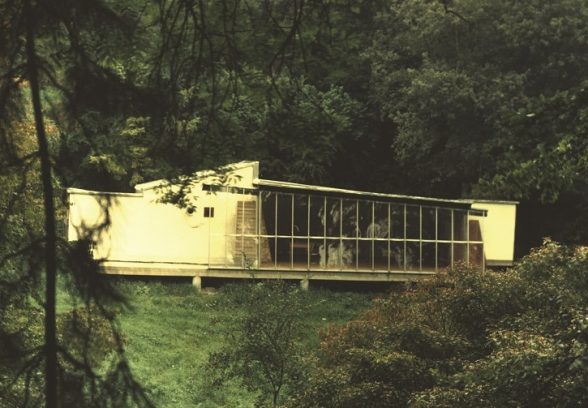This website uses cookies
This website uses cookies to enable it to function properly and to analyse how the website is used. Please click 'Close' to accept and continue using the website.



Horder House, Hampshire
Status: Destroyed
Architect: Edward Cullinan Architects
Praised as an “idiosyncratically English version of the glass-box-in-the-wood”, Horder House in Hampshire is one of the first buildings Ted Cullinan designed. In 1958 when he started working on the remote site, Cullinan was only 27 and working at Denys Lasdun’s office. Horder House was intended as a composing studio for the architect’s uncle Mervyn Horder, and virtually self-built by Cullinan and a retired gardener.
It consisted mainly of pre-fabricated elements, assembled in situ. The generous studio space, fully glazed to collect the sun, was at the centre, stepping forward from the façades of the bedrooms to either side. The structure, held together by two door frames to either side of the studio, sat on concrete beams which in turn rested on slim asbestos pipes, lifting the house off the ground.
Cullinan had, out of necessity of budget constraints but also due to his own interest in self-built architecture, developed a rough aesthetic which he explored to the full also in two other houses, Marvin House in California (1958-60, demolished) and his own house on Camden Mews (1963-4).
Distinguished academic Jonathan Hale , author of the monograph ‘Ends, Middles, Beginnings’* on 40 years of Edward Cullinan Architects ‘ work, wrote :‘This building is easily the most radical of Ted Cullinan’s early houses. As a manifesto statement it bears comparison with Mies van der Rohe’s Farnsworth House – exploring new territory in passive solar design, self-build ‘bricolage’ and an almost deconstructivist formal language of tilted and twisted planes. The design is ordered by a rigorous plan diagram of ‘served and servant’ spaces, as well as a picturesque sensibility towards the placing of objects in the landscape: a classic and idiosyncratically English version of the glass-box-in-the-woods.’
In 2008 the Royal Institute of British Architects awarded Ted Cullinan the UK’s most prestigious architectural award, the Royal Gold Medal for Architecture.
In 2005 the owners received planning permission to demolish the house and replace it with a much larger dwelling. The C20 Society quickly stepped in and submitted an application for spot-listing but this was turned down and the house was later demolished.
This text needs adding

Become a C20 member today and help save our modern design heritage.